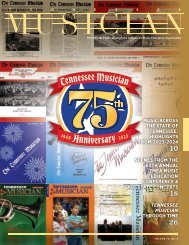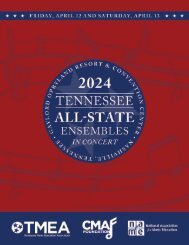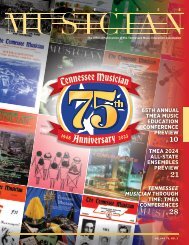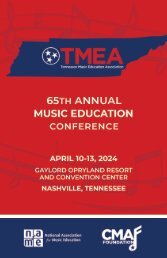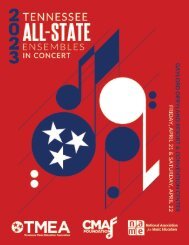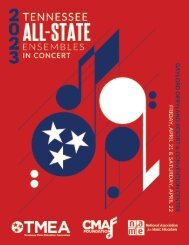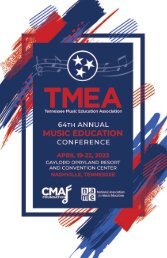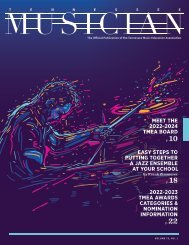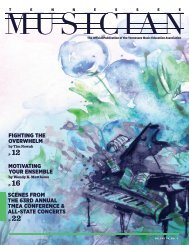You also want an ePaper? Increase the reach of your titles
YUMPU automatically turns print PDFs into web optimized ePapers that Google loves.
TM<br />
President’s message<br />
Jeff Phillips<br />
Greetings! I’m<br />
sure that many of<br />
you are busy working<br />
on your holiday<br />
programs, working<br />
on portfolios,<br />
maybe finishing<br />
marching season,<br />
and busy getting<br />
ready to wrap up<br />
this semester and<br />
plan for another<br />
simultaneously. As<br />
with every year,<br />
especially in education,<br />
change is upon<br />
us! That’s going to be one thing we can always count<br />
on. While we can’t control many of the directives<br />
and initiatives that are required of us, what we CAN<br />
control is our reaction to them and how we CHOOSE<br />
to deal with them. Many of these items shouldn’t be<br />
thought of as things that impede our classroom day to<br />
day teaching, but as ways that we can become better<br />
at our own teaching, organization, and advocacy.<br />
For this issue we will look at the new standards. Before<br />
you begin rolling your eyes and telling me how<br />
you just got familiar with the old standards (and how<br />
you never did figure out how to do the singing/playing<br />
of instruments or that improvisation thing), take a<br />
breath!<br />
To be successful in the classroom, we all have<br />
to have definable goals and a focus of direction for<br />
our instruction. The key component of making these<br />
goals is to have a set of standards for what you expect<br />
to accomplish and how you want to get your students<br />
to the desired level. Whether you take your standards<br />
for curriculum from an older curriculum guide, state<br />
or national standards, or a tried and true set of goals,<br />
you use standards in your classroom (if you don’t,<br />
perhaps we need to talk…)! Our National (and <strong>Tennessee</strong>)<br />
Standards have been in place for some time<br />
now and I think we have all had issues with how to<br />
incorporate so many things into our curriculum. How<br />
do instrumental directors incorporate singing? How<br />
do choral directors incorporate playing of<br />
instruments? What about that improvisation section,<br />
and are we all doing composing and arranging? These<br />
have been the subject of discussion for several years<br />
prior to tying the standards to our classroom teacher<br />
evaluations. <strong>No</strong>w that we have them posted in our<br />
classrooms and are expected to reference these when<br />
we teach, here “they” go and start changing them!<br />
This is where the “new” standards come in. Partly as<br />
an answer to these frustrations we’ve experienced and<br />
as a means to tie what we do in music education to<br />
21 st century skills and college readiness, other teachers<br />
have developed these revisions. This has been a long<br />
process and the “rollout” of the new standards began<br />
last year with opportunities for review from music<br />
teachers at all levels all across the country.<br />
What you’ll find are fewer small standards<br />
and some purposefully broad areas that allow YOU<br />
as a teacher to fit your style of teaching to incorporate<br />
these areas into your lessons and rehearsals. As<br />
we begin to look at these, think of how what you’re<br />
already doing (or have done for years) is already in<br />
line with these areas! Then, how can you utilize these<br />
to better teach your students and assess their performance?<br />
I think you may be pleasantly surprised at<br />
how the areas of “perform, create, and respond” translate<br />
into everyday music education! This is the stuff<br />
WE have been doing all along and now our colleagues<br />
in the school are going to be expected to fit their subjects<br />
into this model. WE have an opportunity to help<br />
them and incorporate MUSIC into all of our subjects<br />
IF we take this challenge and use it to our advantage;<br />
we have a built in advocacy moment just waiting for<br />
us!<br />
Take advantage of the articles and columns in<br />
this issue to spark creativity (or argument!) and let’s<br />
use this as an opportunity to make us better teachers<br />
and our students better musicians. The endless paperwork<br />
and forms, the classroom observations, new<br />
requirements, and everything else we have thrown on<br />
us each year: through all of it, let’s not forget the real<br />
reason that we started doing this “music” stuff in the<br />
first place! In all of those mounds of clerical “stuff”<br />
we teach an incredible art form to our students! YOU<br />
are the most important part of the day for so many<br />
children and YOU are TMEA! - Jeff Phillips<br />
12 www.tnmea.org<br />
TM | <strong>Vol</strong>ume <strong>67</strong> number 1



